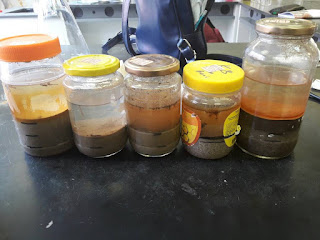Group Members:
| BS16110578 | NG SEAN FONG (CAPTAIN) |
| BS16110531 | SITTI HAJAR BINTI GAFFAR |
| BS16110572 | NABILA AFIQAH BINTI MOHD NAZRI |
| BS13110389 | NOOR AZERRAH BINTI HAPININ |
| BS16110504 | ADREY CALDER YUS ALISUS |
| BS16110493 | CHRISTICA DEIDREEN PHILIP |
1st Week Report PADI SAWAH (CLICK HERE)
2nd Week Report PADI SAWAH (CLICK HERE)
3rd Week Report PADI SAWAH (CLICK HERE)
4th Week Report PADI SAWAH (CLICK HERE)
Overall Summary Report PADI SAWAH (CLICK HERE)
MATERIAL PREPARATIONS:
(1) 5 recycle plastic pots that can fit in about 5 litres of soil.
~ No need to make holes for drainage.
(2) The team need to collect four type of soil (6 litres each).
~ Collect different type of soil texture such as clay, silt, loam and sandy.
~ 1 type of soil will be provided from Mengkabong Lagoon.
~ Collect different type of soil texture such as clay, silt, loam and sandy.
~ 1 type of soil will be provided from Mengkabong Lagoon.
(3) Conduct soil pH test and soil texture triangulation for soil texture type for the report.
(4) Dry at least 500 gram of each of the soil.
~ Before air dry outside the lab, take the wet soil weight measurement for each soil.
~ Measure the dry soil weight after completely dried. Then keep dry for further analysis (nutrient and heavy metal).
(5) Give the same amount of water for each watering session(tap water). Example 500ml water for each pot.
Regularity of watering as follow:
Everyday on the first week.
Alternate days on the 2nd week.
Twice a week during 3rd week.
Once only on the 4th week.
~ Before air dry outside the lab, take the wet soil weight measurement for each soil.
~ Measure the dry soil weight after completely dried. Then keep dry for further analysis (nutrient and heavy metal).
(5) Give the same amount of water for each watering session(tap water). Example 500ml water for each pot.
Regularity of watering as follow:
Everyday on the first week.
Alternate days on the 2nd week.
Twice a week during 3rd week.
Once only on the 4th week.
(6) Ruler/measurement tape
~ to record the growth of the plant.
PROCEDURE:
(1) Air dry some of soil samples (about 500gram) for heavy metal and macronutrient analysis.
~ Before soil are dried outside of the lab, take the measurement of wet soil weight.
~ The week after if the soil is totally dried up, take the measurement of dry soil weight.
~ Keep soil dry until further analyse.
(2) Measure the empty pot. Keep record.
(2) Measure the empty pot. Keep record.
(2) Fill up the pot with soil and cover the seed with soil (2cm deep). Measure the weight of the soil and pot. Keep record.
~ After 3rd week measure each pot and soil each time before you water your plant, so you can estimate the loss rate of water from different type of soil (Create a research question from this and observation data interpretation from this).
~ After 3rd week measure each pot and soil each time before you water your plant, so you can estimate the loss rate of water from different type of soil (Create a research question from this and observation data interpretation from this).
(3) For 1 pot sow 10 seeds each and space them apart from each other, so you can dig out several whole plants at 2 weeks old carefully out from the soil without disturbing other seedlings.
(4) After two weeks dig out 3 whole plant from each pot including the root carefully. Measure the length of the whole plant from root to shoot, root length and shoot length. Weigh the weight of the whole plant clean without soil after plant in dried state.Keep record.
Repeat for a month old plant.
(5) Anaalyse the nutrient content of the soil.
Repeat for a month old plant.
(5) Anaalyse the nutrient content of the soil.
OBSERVATION RECORD:
(1) Germination rate for each pot.
(2) How long does seeds start to sprout an emerge from the soil for each pot.
(3) Mortality/Survival rate of the plant growth.
(4) Growth of the plant of each plant for every week.
(5) Any deficiency symptoms such as yellowing of the leaves.
(6) Nutrient and Heavy Metal amount in the soil samples.(7) Moisture content.
(8) Length of whole plant, root and shoot part separately at 2 weeks and a month old. Wet weight and Dry weight of whole plant without any soil attach.
RESEARCH QUESTIONS:
(1) Among five type of soils which is fertile for growing rice paddy.
(2) How does water content of each soil affect rice paddy growth.
(3) How does different soil texture affect the rice paddy growth.
(4) Nutrient availability for rice paddy from different soil texture.
(5) How does soil texture effect root growth.
(6) How does soil pH influence nutrient availability.
(7) Are they any heavy metal contamination in the soil.
Learn tips on how to grow rice paddy well.
Get to know rice paddy plant.
Don't forget to keep your reference list for your report.
Fill free to add on research questions or observation data.


No comments:
Post a Comment